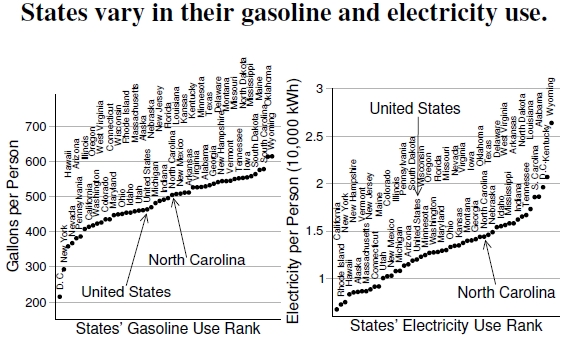3. 2 State Variation
Figure 3.2: Per capita consumption of gasoline, at left, and electricity use, at right, ranked by state-level averages (2003 use data from www.energy.ca.gov). The average American uses about 450 gallons of gasoline, representing about 54 million Btus of energy, and about 12,000 kWh per year, representing about 41 million Btus of energy. Assuming 300 million Americans, these energy uses sum to 30 quadrillion Btus of the total 100 quads for the United States. The remainder comes from commercial and industrial uses.
Per capita gasoline and electricity use (see Figure 3.2) varies widely across states, with California at the low end and Wyoming at the high end.[9] First off, a discussion of gasoline and electricity use requires a short review of energy and power. Applying a force over a distance takes energy, with the Joule, Calorie, and Btu being several such measures.[10] For example, it takes about 10 Joules of energy to lift a kilogram up 1 meter, roughly from your waist to your head.
Power means energy used over a time interval, with the Watt being a common measure. More energy used over the same time interval takes more power, and, likewise, the same energy expended over a shorter time interval. It takes about 10 W of power to apply the force to lift that kilogram up in one second, but it takes less power to apply the same force if you take a longer time to do it. A kiloWatt is 1,000 W, and with that power you could lift 100 kg up 1 m in 1 second, 10 kg up in 0.1 second, or 1,000 kg up in 10 seconds. All three cases require 1 kW of power, but lifting the 10 kg took 0.1 second, requiring 0.1 kW-seconds of energy, the 100 kg took 1 second, requiring 1 kW-seconds of energy, and the 1,000 kg took 10 seconds, or 10 kW-seconds of energy. Your electric company charges you for energy, measured in kilowatt-hours.
One kWh of energy equals 3,400 Btus; the average North Carolinian uses about 14,400 kWh per year, the same as 49 million Btus of electrical energy, and similar to the North Carolinian’s 60 million Btus of gasoline energy use. Here’s another way to see our energy use. Including Alaska, we have 8.2 acres per person.[11] If I took my 500 gallons of gasoline, at about 2.8 kg (and 120,000 Btus) per gallon of gas, and poured it over “my” 8 acres, there’d be 42 grams/m2 (roughly three tablespoons), or 1,800 Btus per square meter per year.[12] Again, compare this energy use to the 6,000 Btus/m2 fixed by plants (Figure 3.17): way too close for biofuels. Likewise, my electricity use works out to about 1,500 Btus/m2. Commercial, industrial, and other transportation uses make up the remainder reported in Figure 3.1.[13]
How does this energy use compare to sunlight’s energy? Every day nearly 28,000 Btus/m2 of energy strikes the top of the atmosphere, of which 16,200 Btus/m2 hits the ground,[14] being available for, say, plants or photovoltaic cells. That number comes to 6 million Btus/m2 each year, compared to our measly annual use of 10,000 Btus/m2! Given the solar energy striking the ground, about 10 m2 of 100% efficient solar panels would satisfy a North Carolinian’s electrical needs, or more realistically, 50 m2 of 20% efficient solar panels, an area roughly 15 ft by 30 ft.[15]
——————————
[9]These numbers say that my family, a total of four people, consumes about 2,000 gallons each year, an amount that half-fills a 4-foot-deep, 15-foot diameter above-ground pool that holds 5,000 gallons. I’m sure my family doesn’t directly purchase 1,000 gallons of gas each year, or two 10-gallon fill-ups per week, but we’re certainly at half that amount. Add in schoolbuses, several gasoline-powered implements, and our air travel and this number becomes believable.
[10]Lifting 1 kilogram by 1 meter against gravity takes almost 9.8 Joules of energy (let’s call it 10). Calories measure food energy, and more generally, things associated with heat, with 1 Calorie equal to 1,000 calories, and one calorie can raise one gram of water by 1C (thus a Calorie raises 1 kilogram of water by 1C). (Note that the capitalization of the word calorie matters.) One Calorie equals about 4,200 Joules. Many home appliances measure energy use in Btus (British thermal units), which roughly equals 1,055 Joules.
[11]Dividing the land area of the United States, 1013 square meters (including Alaska), by the U.S. population, about 300 million, we have 33,000 square meters per person, or 8.2 acres. Excluding Alaska reduces the United States to 6.4 acres per person, or about 26,400 square meters per person.
[12]One gallon of gasoline equals about 120,000 Btus, about 43 Btus/gram, which works out to 60 million Btus for my 500 gallon consumption, or 1,800 Btus/m2 over my 8 acres.
[13]The Annual Energy Review 2008 reports the rough breakdown of energy use, in quadrillion Btus, to be 21.6, 18.5, 31.2, and 27.9, for residential, commercial, industrial, and transportation, respectively.
[14]Kiehl and Trenberth (1997) and Maurellis and Tennyson (2003) provide wonderful discussions of solar energy. In other units, solar energy intensity at the top of the atmosphere is 342 W/m2, and at the ground, 198 W/m2. Conversions use 1 Btu of energy equals 1055 Joules, and the power unit, a Watt, equals 1 Joule/sec.
[15]Even if this solar panel area sounds reasonable enough, at least one 2008 cost–benefit study of solar panels demonstrated that they’re not cost effective, even when factoring in nonmarket values (Borenstein 2008).
